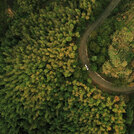
A global meta-analysis of 221 landscapes found that forest restoration enhanced biodiversity by 15-84% and vegetation structure by 36-77% as compared to degraded ecosystems. While restoration did not fully recover original biodiversity and vegetation structure, the primary drivers for success in the landscapes examined were time elapsed since restoration began, disturbance type, and landscape context.
Crouzeilles, Renato, Michael Curran, Mariana S. Ferreira, David B. Lindenmayer, Carlos E. V. Grelle, and José M. Rey Benayas. A global meta-analysis on the ecological drivers of forest restoration success. Nature Communications 7, 11666 (2016). https://doi.org/10.1038/ncomms11666
